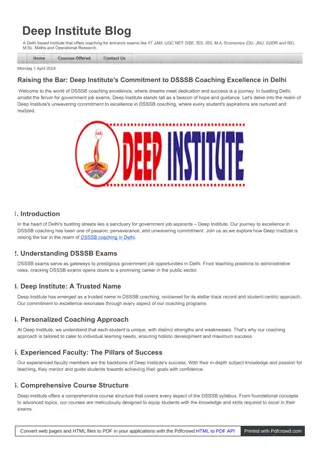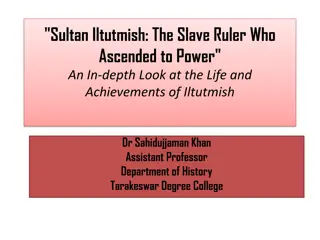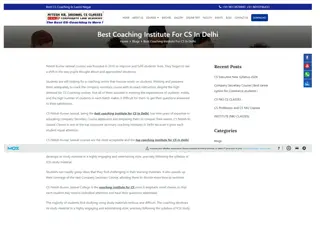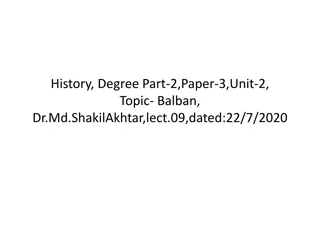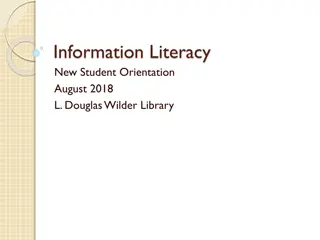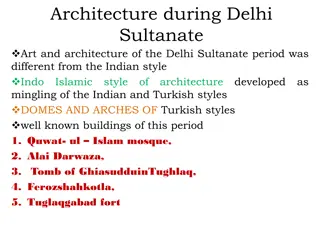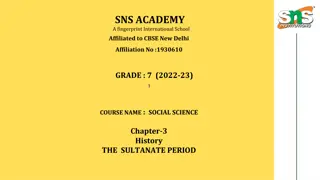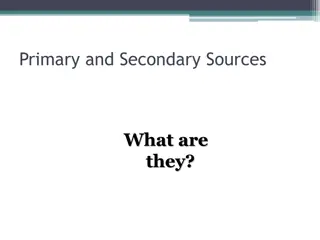Sources of Information in Delhi Sultanate Period
The sources of information in the Delhi Sultanate period include inscriptions found on coins, monuments, and tombstones. Historical writings in Persian language provide valuable insights into the administration and history of the Sultanate. Epigraphs and numismatics also play crucial roles in understanding the establishment of Muslim rule in India and the political entities during that time.
Download Presentation

Please find below an Image/Link to download the presentation.
The content on the website is provided AS IS for your information and personal use only. It may not be sold, licensed, or shared on other websites without obtaining consent from the author. Download presentation by click this link. If you encounter any issues during the download, it is possible that the publisher has removed the file from their server.
E N D
Presentation Transcript
B.A.(HONS) HISTORY SEMESTER-2 UNIT-1 HISTORY OF INDIA 650 C 1550 A.D
SOURCES- EARLY, MEDIEVAL AND SULTANATE PERIOD. The main sources of Delhi Sultanate are inscriptions. They are found on old coins, historical monuments, milestones, and tombstones. Monuments are also an important source of information about the Delhi Sultanate. We also get information about the Sultanate from the history written in the Persian language (official language under the Delhi Sultanate) known as tarikh or the tawarikh. The tawarikh were written by learned men who often occupied important posts in the administration.
EPIGRAPHY These epigraphs as a rule date from the last decade of the 12th century, when permanent Muslim rule was established in northern India, and a short time later elsewhere. Under the Arab occupation of Sind or the later Ghaznavid occupation of the northwestern region, including Punjab and coastal strips of Gujarat, Konkan, Malabar, and Coromandal, early Muslim settlers quite likely had left such records. No trace of them, however, has been found. The so-called first and second century Hijra (7th and 8th centuries) epigraphs reported at Kovelam near Madras and Kollam in Malabar (now part of Kerala) either no longer exist or have been incorrectly read. About a dozen early records, all in Arabic, have been found in Sind and frontier provinces of Pakistan, and in Gujarat and Haryana states of India. With most parts of the subcontinent gradually coming under Muslim occupation, the number of these epigraphs increased. They covered almost the entire subcontinent and represented all imperial, provincial, or minor rulers during almost three-fourth of the second millennium.With an exception or two, the language of these epigraphs remained Arabic for about half a century. Toward the close of the 13th century, the Persian state language was widely used in epigraphs. Under the Mughals (1526-1858), Persian replaced Arabic almost throughout the region. Also after the British established power, Persian remained the medium of epigraphical text. Even after more than four decades of independence, Persian continues to hold its sway. Urdu, the unofficial lingua franca until independence, now gains somewhat more currency, particularly in outlying (mofa al) areas. In westernmost Gujarat, one encounters a curious phenomenon: both prose and verse epigraphs of the Delhi sultanate period (1296-1406), are generally in Persian, but later replaced by Arabic under the Gujarat sultans (1406-1580). Persian records there are not, however, as rare as in Bengal. Again, under the Mughals Persian eased out Arabic, and under British rule it was in vogue. In the northern and central regions, under the Delhi sultanate and provincial kingdoms of Jaunpur, Malwa, etc., Persian made its appearance in the second half of the 13th century and was used more or less universally from the second half of the 14th century. These epigraphs, like their Indian counterparts in Sanskritic and Dravidian languages, are basically commemorative. They report events, including construction of religious edifices such as mosques and mausoleums; military structures such as forts, city-walls, gateways, and bastions; secular buildings such as palaces, mansions, pleasure-pavilions, and granaries; and public works such as tanks and cisterns, step-wells and wells, dams and embankments, caravanserais, or schools. Epigraphs communicated state administrative orders or edicts, regarding levy or remission of duties; ordered discontinuation of unauthorized imposts or practices introduced by local officials; and adjusted rates and prices of consumer goods.
Numismatics The earliest Mohammedan Kingdom in India was set up by Imadu-d-din Qasim in Sindh around 712 AD, but politically it wasn't a significant entity and hence the coinage is not explained in this section. The expedition of the great Sultan Mahmud of Ghazni opened up the northern frontier of India in about 1051, and it wad that time the Lahore was annexed and the billon coinage was circulated by him. He retained the classical and popular Rajputan device "The Bull and the Horseman" but engraved Arabic legend in the Cufic script. The last of Ghaznavid prince of Lahore, Khusru Malik was deposed in 1187 AD by Muhammad Bin Sam of Ghor and there came the beginning of the first Mohammedan dynasty of India. To express the greatness of their numismatic art, the coinage could be subdivided into three subsections namely 1. From the accession of Qutubud-d-din Aibak (1206 AD) till the Ghiyasud-d-din Tughluq's rule (1324 AD), 2. Reign of the great Muhammad Bin Tughluq and 3. From the accession of Firoz Shah-III till the death of Ibrahim Lodi (1526 AD). 1. The Early Sultans (1206 AD - 1324 AD) Muhammad Bin Sam initiated the coinage of Hindu Kings of Kanauj to have wide acceptance by his new subjects. The obverse carried the classical Kushan-Gupta-Rajput device of Lakshmi seated on the obverse, and his title in Nagari on the reverse. The silver coinage too struck in imitation to the classical Bull and Horseman style but with his name surrounding the bull and the horseman symbol. Iltumish's coinage are quite unique compared to his predecessors, he struck tankahs with "King Riding the horse" on the obverse. The Indo-Greek/Sakas tradition of minting coins with the horse rider could be recalled here. The later types were engraved with the diploma of investiture that he had obtained from the Khalif of Baghdad. The legends were enclosed within the circle having a circular margin embedding king's name and the title. The tradition of the coinage struck by Iltumish was followed till the accession of Balban. The gold coins were very scarce due to the fact that gold was not that easily available. Especially, the gold coinage of Alau-d-din Khilji, Nasiru-d-din Mahmad and Alau-d-din Masud are very rare. It is only during Alaud-d-din Muhammad (1296 - 1316 AD), the southern conquest filled the treasury through war booties and gold coinage were minted in abundance. Silver tankah seems to be little scarcer and the divisional pieces of Tankahs are rarer. Alaud-d-din Muhammad deviated the classical coinage style of his predecessor and called himself as "The second Alexander, the right hand of the Khalifate". Qutubud-d-din Mubarak's coinage is very interesting. He employed the earlier square form which were very popular in ancient India during 3rd century BC to 1st century AD, mostly struck by the Mauryas/Magadhas/Indo Greeks. His coins represented little more arrogant title as can be seen by the legend "The supreme head of Islam, the Khalif of the Lord of Heaven and Earth". Ghiyasu-d-din Tughluq was the first Sultanate to use the title "Ghazi", the Champion of the faith. This could be seen followed by the later Mughals. Tankahs of Shamsu-d-din Kaiyumar's (the infant son of Kaiqubad) are very rare due to his shorter reign of three years. Shihabud-d-din Umar's coinage are extremely rare due to the fact that he was on the throne only for few months!
The Coinage of Muhammad Bin Tughlaq (1325 AD - 1351 AD) A remarkable ruler among Delhi Sultans, Muhammad Bin Tughlaq is known for his active interest in experimenting with the coinage. He implanted his character and activities on his coinage and produced abundant gold coins compared to any of his predecessors. He overtook them by executing a fine calligraphy and by issuing number of fractional denominations. An experiment with his forced currency places him in the rank of one of the greatest moneyers of Indian history though it wasn't successful in India. The large influx of gold due to his southern Indian campaign made him to adjust the weight standard of coinage which was in usage all the while. He added the gold dinar of weight 202 grains while compared to the then standard weight of 172 grains. The silver adlis weighed 144 grains weight and was his innovation aiming to adjust the commercial value of the metal with respect to gold. Seven years later, he discontinued it due to lack of popularity and acceptance among his subjects.All his coins reflect a staunch orthodoxy. The coins stuck at both Delhi and Daulatabad, were curious and was issued in memory of his late father. The Kalima appeared in most of his coinage, the title engraved were "The warrior in the cause of God", "The trustier in support of the four Khalifs - Abubakkar, Umar, Usman and Ali". He minted coins in several places such as Delhi, Lakhnauti, Salgaun, Darul-I-Islam, Sultanpur (Warrangal), Tughlaqpur (Tirhut), Daulatabad(Devagiri), Mulk-I-Tilang etc., More than thirty varieties of billon coins are known so far, and the types shows his numismatic interest. The copper coins are not that fascinating compared to the billon and his gold coinage, but were minted in varieties of fabric. Most wonderful of his coinage is the forced currency. He had two scalable versions, issued in Delhi and Daulatabad. They obeyed two different standards, probably to satisfy the local standard pre-existed in north and the south. Sultan's skill in forcing the currency is remarkable. He engraved "He who obeys the Sultan obeys the compassionate" to fascinate people to accept the new media. Inscriptions were even engraved in Nagari legend, but because of the metal which is made, the coinage doomed. The easily forgeable Copper/Brass coinage turned every Hindu house into a mint and soon Sultan withdrew forged currency by paying in Billon and gold!!!
From 1351 AD - 1526 AD) Historians did comment about the disastrous consequences of Muhammad Bin Tughlaq's reign, but in fact it was not due to his bad policies. His successor Firoz Shah Tughlaq inherited the full treasuryto undertake various monumental constructions work. The gold coin of Firoz Shah is fairly common like his predecessor. Atleast six different types were known, they too exhibited similar traditional theme inscribing the name of Khalifs Abul Abbas and his two successors. The obverse portrayed "The right hand of the commander of the merciful" and "the deputy of the commander". The latter appears in almost every successors coinage until Bahlol Lodi's reign. Gold and silver pieces are scarce entities after Firoz Shah's reign. Hardly few silver pieces of Firoz, Mohammed Shah, Muhammad bin Tughlaq, Mubarak Shah-II and Alam Shah does exist. Billon coins namely Adlis though produced in bulk, largely varied in proportion of silver alloy ingredients but they were of the same standard set by Md Bin Tughlaq. The long reign of Firoz made his coinage as a popular media and one can see large number of posthumous issues extending for atleast fouty years! Some of these and the posthumous issues of his son Muhammad and grandson Mahmud were continually struck by Daulat Khan Lodi and Khizr Khan. Coinage of Lodi family namely Bahlol, Sikander and Ibrahim resembled that of Jaunpur coinage except for the difference in its weight standard. Bahlol's billons are abundant and fairly common too. The mint name Delhi and ShahJaunpur are common in Bahlol's coinage. Later when Sharqi kingdom was reduced in 1476, billons adopted the formula "Trusting in the merciful one". In 1526, the Panipat decided the fate of numismatic art and the Indian coinage changed under the auspices of the Mughal dynasty.
LITERATURE Several biographies, autobiographies, court histories, chronicles, accounts of foreign travelers, and private correspondence give us information about the history of the Delhi Sultanate. Tarikh-i-Firozshashi is an important work in medieval India. Written by Ziauddin Barni, it gives an account of the political, social, and economic conditions prevailing in India during those times. Prithvirajraso is an epic poem written by Chand Bardai. The poem narrates the heroic exploits of Prithviraj Chauhan who ruled Ajmer and Delhi from AD 1165 to AD 1192. It gives us glimpses of the socio-political condition of the country at that time. The poem though does not give us an accurate account of the battle which took place between Muhammad Ghori and Prithviraj Chauhan. It is an important source of information on the social and clan structure of the Kshatriyas of northern India.
REFERENCES www.forumancientcoins.com homeoflearning.in www.jstor.org www.slideshare.net www.academia.edu












